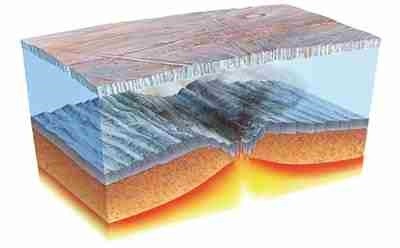By Ana Verayo, | January 19, 2016

Underwater volcanism led to major changes in ocean chemistry.
New research reveals how extreme underwater volcanism spanning almost the entire Earth's oceans caused the breaking up of an ancient supercontinent, forcing the planet to enter into extreme freezing climates some 750 million years ago.
Scientists from Australia University and University of Southampton believe that this can also explain how life began on the planet starting with animals, some millions of years after this crucial event.
Like Us on Facebook
According to co-author of the study, Eelco Rohling from the Australian National University, this extreme event is dubbed as "Snowball Earth" where the planet almost did not survived it or escaped it.
In the Snowball Earth theory, during the evolution of the planet, the Earth was at least once covered entirely in ice sheets however, there is no clear cause of this extreme glaciation. Scientists believe that runoff water from rivers escaping into bigger oceans caused this breaking up of massive supercontinent known as Rodinia, leading to a change in chemistry in the ocean.
This eventually reduced the amount of carbon dioxide in the atmosphere, that triggered the increase of global ice around the planet.
Since there is a massive amount of ice sheets on the planet, its vast coverage across the continents ultimately reflected sunlight away, bouncing off the Earth's surface, that lead to more cooling of the planet.
Rohling adds that this forces the whole world into a tipping point that resulted in a snowball state when the oceans began to freeze over. This sea ice formation is produced by a large scale glaciation on land as well. Scientists now believe that the Earth remained in this freezing state for millions of years.
The team also says that eventually, extensive land based volcanism released and spewed so much carbon dioxide into the atmosphere that it pushed the planet out of this Snowball Earth phase.
However, this theory still does ot explain how thick deposits of carbonate rock like limestone, also known as cap carbonates, were formed when the planet began to warm again.
Simulations performed by the team revealed that when supercontinent Rodinia was broken up, this geologic activity released massive volumes of volcanic material and chemicals that saturated the oceans, absorbed carbon dioxide from the atmosphere, that eventually cooled down the planet.
This continental breakup released large amounts of glass made from shallow marine volcanic activity, known as hyaloclastite in which released large amounts of chemical into oceans upon breaking down in the water. These hyaloclastite eruptions caused the oceans to become rich in calcium, magnesium, silicon and phosphorus, which explains rich mineral deposits despite massive ice sheets covering the planet.
When the planet warmed again, the ice broke apart, allowing light to penetrate into oceans as algal life developed and began photosynthesis. Since the oceans were rich in minerals, this generated large algal blooms that paved way for life on the planet, adds Rohling.
This new study is published in the journal Nature Geoscience.
-
Use of Coronavirus Pandemic Drones Raises Privacy Concerns: Drones Spread Fear, Local Officials Say

-
Coronavirus Hampers The Delivery Of Lockheed Martin F-35 Stealth Fighters For 2020

-
Instagram Speeds Up Plans to Add Account Memorialization Feature Due to COVID-19 Deaths

-
NASA: Perseverance Plans to Bring 'Mars Rock' to Earth in 2031

-
600 Dead And 3,000 In The Hospital as Iranians Believed Drinking High-Concentrations of Alcohol Can Cure The Coronavirus

-
600 Dead And 3,000 In The Hospital as Iranians Believed Drinking High-Concentrations of Alcohol Can Cure The Coronavirus

-
COVID-19: Doctors, Nurses Use Virtual Reality to Learn New Skills in Treating Coronavirus Patients







